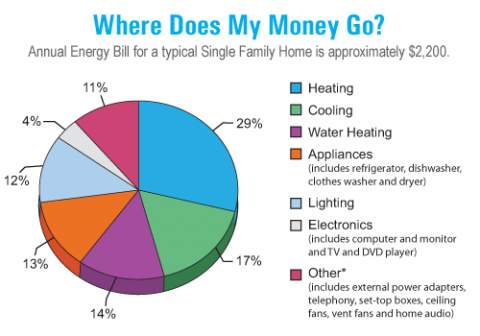In order to start saving money on your energy bills and understand home energy consumption, you have to know where the best place to start is. You could spend your whole life dedicated to cutting out all of your vampire loads, but that probably isn’t going to be the best use of your time when going after heating and cooling would produce a much bigger bang for your buck (and time).
The pie chart above shows the percentage of energy consumed in regards to energy bills in the typical American household. The chart was constructed from a Dept. of Energy survey and shown on the Energy Star website.
The majority of the money you spend in your house is dedicated to heating and cooling. This is followed by water heating and then lighting. So your top three targets are as a percentage of your bill:
- Heating and Cooling (49%)
- Water Heating (13%)
- Lighting (10%)
The good news is that these are the three easiest areas to make an impact!
Heating/Cooling
There are two ways to make an impact in heating/cooling. You can either:
- buy new systems (like geothermal or mini-split heat pump) or
- use the systems you have smarter.
We touched on this in my Programmable Thermostat intro. If there was one step you could take to make an impact on your energy bill it would be using your thermostat smarter. The great part is that this is incredibly simple. All you have to do is make a tiny effort to set your thermostat at a level you can live comfortably at.
Check out our list of WiFi programmable thermostats for some of the most advanced thermostats on the market!
Water Heating
There are two main ways to reduce the energy used to heat your water:
- Use less hot water!
- Turn down your temperature setting on your heater to 130° F (don’t do much lower to prevent Legionnaires Disease). We’ve written a post on determining the temperature of your hot water if your water heater doesn't have a temperature display.
You can also buy a more efficient water heater. If you have to heat your water with electricity (as opposed to natural gas) electric heat pump water heaters are some of the most efficient water heaters on the market.
Lighting
And finally you should target your lighting.
- Install CFL’s or LEDs. Do this now. Use our lighting cost calculator if you don’t believe how much money they will save. And the light quality on today's CFL's and LED's is just as good as incandescents.
- Install lighting timers and sensors to automatically turn lights off when not in use
You can find Mapawatt's list of popular screw-in LED bulbs here.
Conclusion
Find out where your big targets are, and knock them out first. For instance, in the graph at the top of the page, electronics (which makes up most of vampire loads) only represent 7% of most American’s energy bill. The majority of the energy they use is when the electronics are on: watching TV, working on your computer, listening to your stereo, etc. The rest of the time they are in standby mode, but this standby (vampire) load only represents between 1-5% of your overall bill! So if you were extremely dedicated and unplugged all your electronics when you weren’t using them, then plugged them back in when you needed to use them, the most you could save would probably be 5% on your energy bill! Is this the best use of your energy saving time and effort?
I’m not saying you shouldn’t cut out your vampire loads, but spend your time wisely and make sure you target the biggest energy consumers first, then start targeting other areas!
Knowing where to start is half the battle, and Mapawatt is here to help.


Post new comment